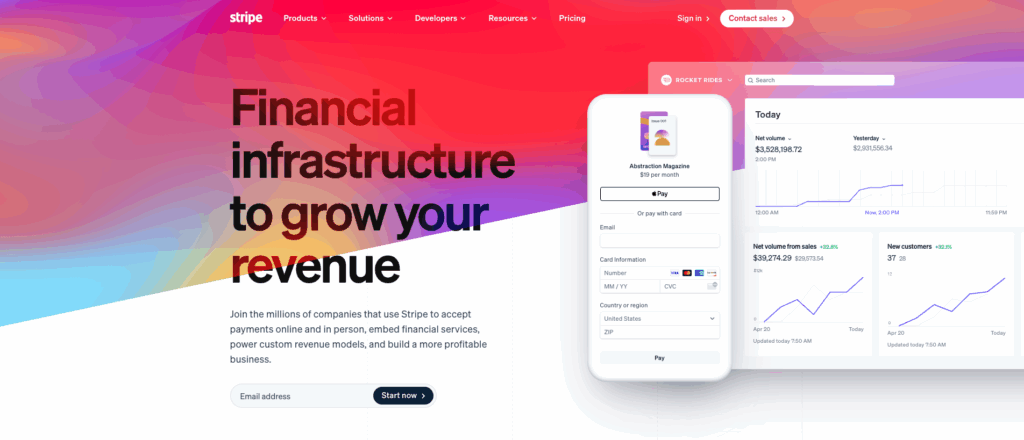Fintech app development is booming, but for most founders and product leads, the biggest mystery isn’t how to code the app, but how much it costs to build one.
You have a vision and a fast-moving market, yet too many jump into app development blindly with vague quotes, underestimate compliance, security, and hidden expenses. Suddenly, what looked like a $50,000 project balloons into $200,000, and timelines stretch.
This often leads to further delays, rework, or apps that fail to perform in a competitive market. Therefore, we’ve made a guide that breaks down the true cost of fintech app development in 2025, covering everything from design to deployment.
By the end of this post, you won’t just know how much it could cost, you’ll know how to control that cost, align it with your business goals.
Understanding the FinTech Market in 2025
The FinTech industry is experiencing explosive growth, with rapid advancements in technology and changing user expectations. According to Allied Market Research, the global fintech industry is expected to grow at a compound annual growth rate (CAGR) of over 20%, potentially surpassing USD 500 billion by 2030.
Key Trends Shaping Fintech in 2025
Decentralized Finance (DeFi) and Blockchain Applications
DeFi platforms are redefining financial accessibility by eliminating intermediaries. Apps like Aave and Compound empower users with peer-to-peer lending, staking, and asset management using blockchain infrastructure. Expect more blockchain-based fintech apps focusing on security, transparency, and global reach.
AI-Powered Financial Services
Artificial intelligence transforms personalized financial planning, real-time fraud detection, and customer support. Tools like Cleo and Upstart are leveraging AI to deliver smarter lending and budgeting services. As users expect intuitive, data-driven experiences, AI in fintech app development becomes a non-negotiable feature.

Embedded Finance and Super Apps
The rise of Buy Now, Pay Later (BNPL) services like Afterpay and Klarna, and all-in-one financial platforms such as Revolut, signal a shift toward embedded finance. These apps integrate banking, payments, and investing into seamless user journeys, increasing customer lifetime value.
Regulatory Changes and Compliance Costs
Regulatory landscapes are tightening across markets. From GDPR in Europe to CDR in Australia, compliance is now a significant cost factor in fintech app development. Apps that proactively embed data privacy, KYC, and AML protocols will gain a competitive edge.

Cost Breakdown Based on Financial Applications
The cost to develop a fintech app in 2025 depends on the specific type of financial application. Each category presents unique complexities, features, and compliance requirements, impacting the cost of app development.
Below is a detailed breakdown of typical development costs across various fintech app categories:
1. Personal Finance Apps
These apps focus on budgeting, expense tracking, and financial goal setting. Developing a personal finance app typically costs between $25,000 and $50,000, depending on the feature set and complexity.
2. Digital Banking Apps
Full-service mobile banking applications replicate and enhance traditional banking functionalities. The cost of developing a mobile banking app can range from $50,000 to $500,000 or more, influenced by factors such as feature complexity, security requirements, and integration with banking systems.
3. Investment and Trading Platforms
If you want to build the next Robinhood, you can expect to pay from $60,000 to $120,000. This price is based on the must-have app features such as real-time market data, KYC verification, portfolio tracking dashboards, and secured payment gateways. KYC alone requires a third-party service, adding $0.50- $2 per user verification.
4. Lending Apps
Loan marketplaces or peer-to-peer lending apps require robust risk assessment models and identity verification. The average cost to develop a loan lending app varies from $20,000 to $150,000, influenced by app complexity, design, and the development team’s expertise.
5. Insurtech Apps
These applications streamline policy management, claim processing, and user profiling. Developing an insurance app can range between $50,000 and $70,000.
6. Cryptocurrency Apps
Apps for crypto wallets or trading platforms demand robust encryption and real-time blockchain connectivity. The development cost of a digital wallet application varies from $30,000 to $100,000 or more, depending on the wallet type (custodial vs. non-custodial), required features, and security complexity.
Each type of application presents its challenges, directly influencing development costs. The mentioned costs are based on the US and European development rates.
Key Factors Influencing Fintech MVP Development Costs
Building a fintech Minimum Viable Product (MVP) involves balancing cost, functionality, and speed to market. The cost to develop a fintech app in 2025 is shaped by several key factors, such as technical complexity, team location, etc. Understanding these variables is essential for budgeting and planning a successful fintech project.
1. App Complexity and Core Features
The scope and depth of features are the biggest cost drivers. Basic fintech MVPs, such as a digital wallet with user authentication, transaction history, and basic reporting, will cost significantly less than an advanced solution with AI-driven analytics, multi-currency support, or cryptocurrency integration. These require sophisticated backends, advanced database architectures, and seamless API connectivity.
For instance, the basic MVP may cost around $30,000 – $70,000, whereas advanced MVP costs $1,00,000+.
2. UI/UX Design Requirements
An intuitive UI/UX design is essential to gain user trust and drive engagement. According to UXCam, Investing just $1 can bring back $100 (9900% ROI). A well-done UX can triple your website’s conversion rate. High-quality design goes beyond aesthetics, it involves wireframing, prototyping, A/B testing, and user journey optimization. While fintech app UI/UX design costs anywhere from $5,000 to $25,000+, the investment pays off in higher user satisfaction, reduced churn, and improved retention. If you’re looking to maximize your app’s potential, partnering with a specialized fintech UI/UX design agency can ensure a conversion-driven experience.
3. Platform Choice: iOS, Android, or Cross-Platform
Choosing your target platform also influences your budget. Native vs cross-platform fintech app cost comparison is essential to finalize the platform for app development.
Native app development for iOS or Android ensures high performance, better device optimization, and smoother animation. However, this choice directly impacts cost, performance, and long-term scalability, making it essential to weigh the pros and cons carefully.
Alternatively, cross-platform frameworks like Flutter or React Native can save time and are more budget-friendly. Since they allow 70% code reuse across iOS and Android platforms, the development cost is 30-50 % cheaper than native. However, these may come with limitations for highly advanced fintech features such as biometric security or real-time data visualization. They also have limited access to the latest OS-specific APIs.
4. Third-Party Integrations
Fintech apps typically rely on multiple third-party services to ensure seamless functionality. Common integrations include:
- Payment gateways (e.g., Stripe, PayPal, Razorpay)
- KYC/AML verification services (e.g., Jumio, Onfido)
- Banking APIs (e.g., Plaid, Yodlee)
- Analytics and user behavior tools (e.g., Mixpanel, Google Analytics)
Each integration involves licensing fees, API usage costs, and extra development hours. Depending on the number and complexity, this can add $10,000 to $50,000 or more to your total budget.
5. Security and Compliance Standards
Security is the cornerstone of any fintech application. It is non-negotiable in fintech apps and can significantly impact MVP development costs. Apps must adhere to strict data protection and financial regulations, such as:
- PCI DSS for handling payment card information
- GDPR or CCPA, depending on your user region, to protect personal data
- PSD2 for enabling secure open banking in the EU
However, regulatory compliance alone isn’t enough. Fintech MVPS require implementing advanced security measures such as end-to-end encryption, multi-factor authentication (MFA), tokenization, and secure API protocols. The level of security integration required can notably increase the MVP development timeline and associated costs.
6. Development Team Location and Structure
The location and composition of your development team can dramatically affect the overall cost. Rates typically vary by region:
- North America or Western Europe: $100–$250/hour
- Eastern Europe: $40–$100/hour
- South Asia or Latin America: $20–$60/hour
This offshore fintech development cost comparison shows that outsourcing to cost-effective regions like South Asia can reduce development expenses. You can also opt for staff augmentation to develop a high-quality fintech application, without compromising quality. A dedicated fintech development partner with experience in security, finance, and scalable architecture can offer better long-term ROI.

Must-have features in a Fintech App
The goal of a fintech MVP is to deliver core value while maintaining a lean, focused product. Including the right foundational features is crucial for functionality, user trust, and regulatory compliance.
Here are the must-have features that typically shape the scope and cost of a fintech MVP:
- User Onboarding & KYC: A seamless registration process paired with Know Your Customer (KYC) checks to ensure compliance with financial regulations from day one. This is one of the crucial features for an MVP to authenticate the identity of the app users. Such a feature requires third-party support, which is charged per user.
- Secure Authentication: Multi-factor authentication (MFA), biometrics, and session management are essential for user security and regulatory standards.
- Account Management: Users should be able to manage their profiles, link bank accounts, and view transaction histories.
- Payment & Transfers: Core to most fintech apps, this includes peer-to-peer payments, bank transfers, and integration with payment gateways (e.g., Stripe, Plaid). The basic integration, such as single payment flow, card payments only, can cost anywhere from $1500 – $5000. The estimated cost of more advanced integration, such as multi-currency, user dashboards, and financial reporting, ranges from $15,000 – $40,000+.
- Real-Time Notifications: Instant alerts for transactions, logins, and system activity are essential for a fintech app to improve transparency and user trust.
- Data Encryption & Security Protocols: End-to-end encryption, tokenization, and secure APIs protect sensitive user data. Several tools are required for security protocols – OpenSSL, AWS KMS, PayPal Vault, Postman, AWS API Gateway, depending on the scope. Even the basic implementation can cost around $5,000.
- Admin Dashboard: An admin dashboard is a backend interface to monitor transactions, manage users, and control app configurations. It can provide automated alerts for failed transactions, audit logs of admin actions, and manage API keys. The estimated average cost of the admin panel ranges from $3,000 to $6,000.
Choosing these features strategically ensures the MVP delivers value while keeping development costs aligned with business goals.
Cost-Saving Strategies for Your Fintech MVP in 2025
Building a fintech MVP doesn’t have to exhaust your budget. With the right strategies, you can minimize costs while still launching a secure, functional, and scalable product. Here’s how to stay lean and efficient:
1. Prioritize Ruthlessly
Focus only on the features that solve a core problem or validate your business model. Leave out nice-to-haves for later stages. This keeps development lean and time-to-market fast.
2. Leverage Pre-Built Solutions
Use proven APIs and third-party services for key functionalities like:
- Payment gateways (Stripe, Plaid)
- Authentication (Auth0, Firebase)
- Analytics and fraud detection
This avoids the high cost of custom development and accelerates your timeline.

3. Use Cross-Platform Frameworks (When It Makes Sense)
Tools like Flutter or React Native can help you deploy to both iOS and Android faster. While they may not fully match native performance, they’re ideal for early-stage MVPs with limited budgets.
4. Phased Development
Break the MVP into smaller, testable phases. This allows you to learn from users and prioritize updates based on actual feedback, avoiding unnecessary rework.
5. Invest in Core UI/UX
Don’t overspend on flashy visuals. Instead, focus on clean, intuitive design for critical flows like onboarding, payments, and account management to build trust and drive engagement.
6. Test Early, Test Often
Bugs in financial apps can be costly, leading to financial and reputational damage. Prioritize QA testing for core features to ensure a stable, bug-free experience from day one.
7. Tap Into Remote or Offshore Talent
Hiring skilled developers from cost-effective regions (like South Asia or Eastern Europe) can drastically reduce expenses. Just ensure strong communication and project oversight. For a strategic approach, consider staff augmentation for fintech in Asia.
8. Choose the Right Development Model
- In-house: Provides full control, aligned culture, but comes with high upfront costs (salaries, benefits, infrastructure). This model is suitable when a long-term roadmap and consistent innovation are key.
- Outsourcing: Save 30-60% development costs compared to hiring a full in-house team, access to global talent, and faster ramp-up. However, the quality depends on your software outsourcing partner. You can use this when you need to launch quickly without scaling your internal team.
- Staff Augmentation: This model allows budget optimization by outsourcing non-core tasks while retaining strategic control internally. It provides a strategic balance for your project execution. Augmenting with remote staff can help you retain control over critical components.
9. Adopt an Agile Approach
Use agile methodology to test your MVP quickly, iterate based on feedback, and avoid building unnecessary features. This ensures every dollar spent moves the product forward.
With these strategies, you can develop a fintech MVP that’s cost-effective, high-performing, and ready to scale without compromising quality or user trust.

Real-World Case Studies
Looking at successful fintechs can offer a valuable perspective on how a lean MVP can evolve into a full-scale product. Here are two standout examples:
Revolut
Revolut began in 2015 with a focused MVP: a simple, app-based currency exchange platform. The initial product let users exchange currencies at interbank rates, solving a real pain point for travelers and digital nomads. With a clean UX, strong security, and a focused value prop, it quickly took off within a few months of launching, reaching 100,000 users. Today, it’s a full neobank offering everything from global accounts to crypto trading. The estimated MVP cost was approximately $83,000.
Lemonade
Launched in 2016, Lemonade disrupted the traditional insurance industry with an AI-driven platform for renters’ insurance. The MVP featured instant quotes and claims through a chatbot interface, appealing to a younger, tech-savvy audience. Lemonade’s emphasis on automation and transparency facilitated its expansion into other insurance sectors. The estimated MVP cost can range between $45,000 to $200,000.
Need a fintech app built on a Budget?
Developing a fintech app in 2025 is both a significant investment and a strategic move. With rising user expectations and tight regulatory landscapes, understanding where and how your budget will be allocated is essential. By planning carefully and partnering with experienced professionals, you can build a fintech app that not only competes but leads.
Ready to explore your fintech idea? Start with a discovery session to define your scope and get a tailored cost estimate from experts who know the space inside out.


